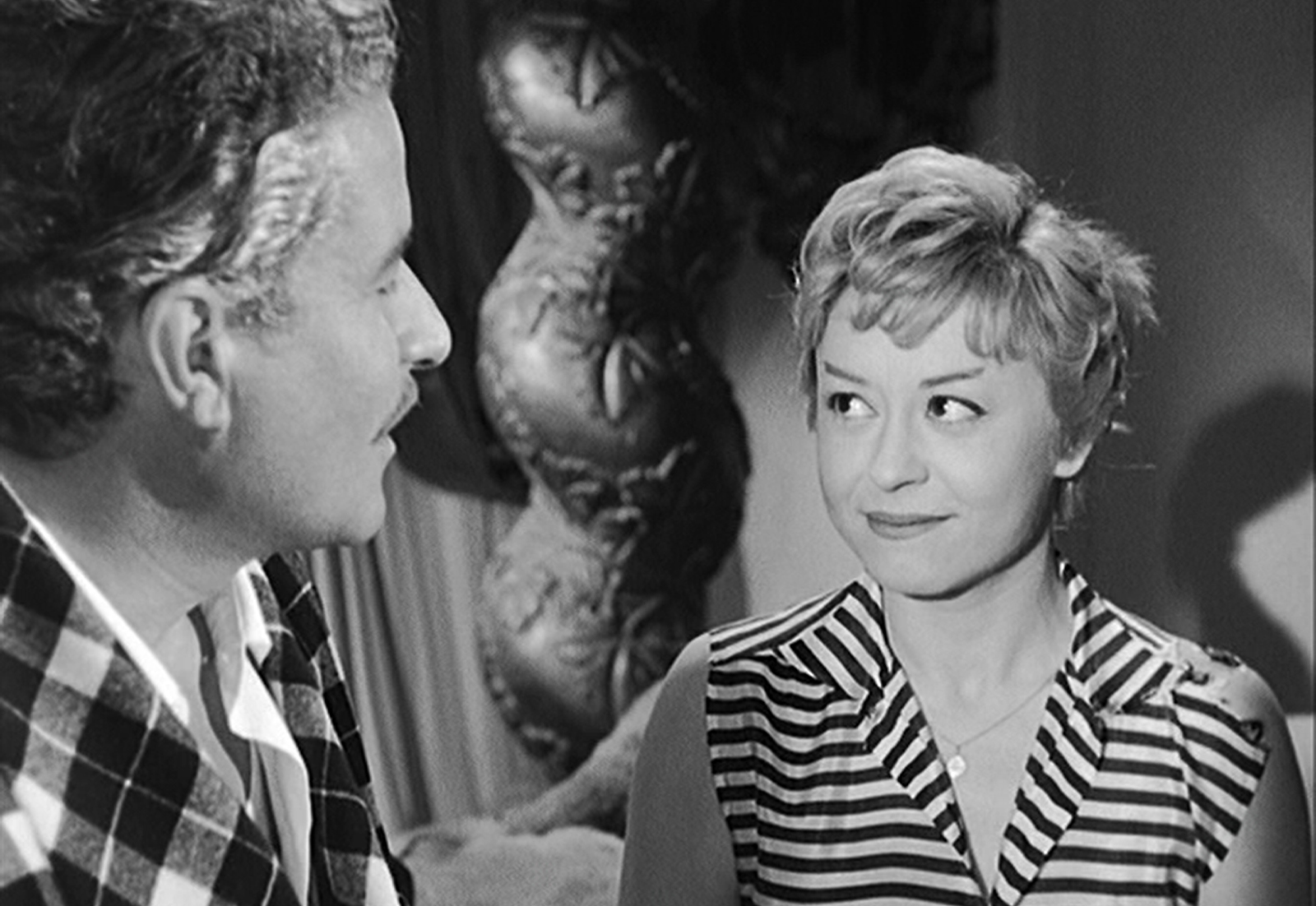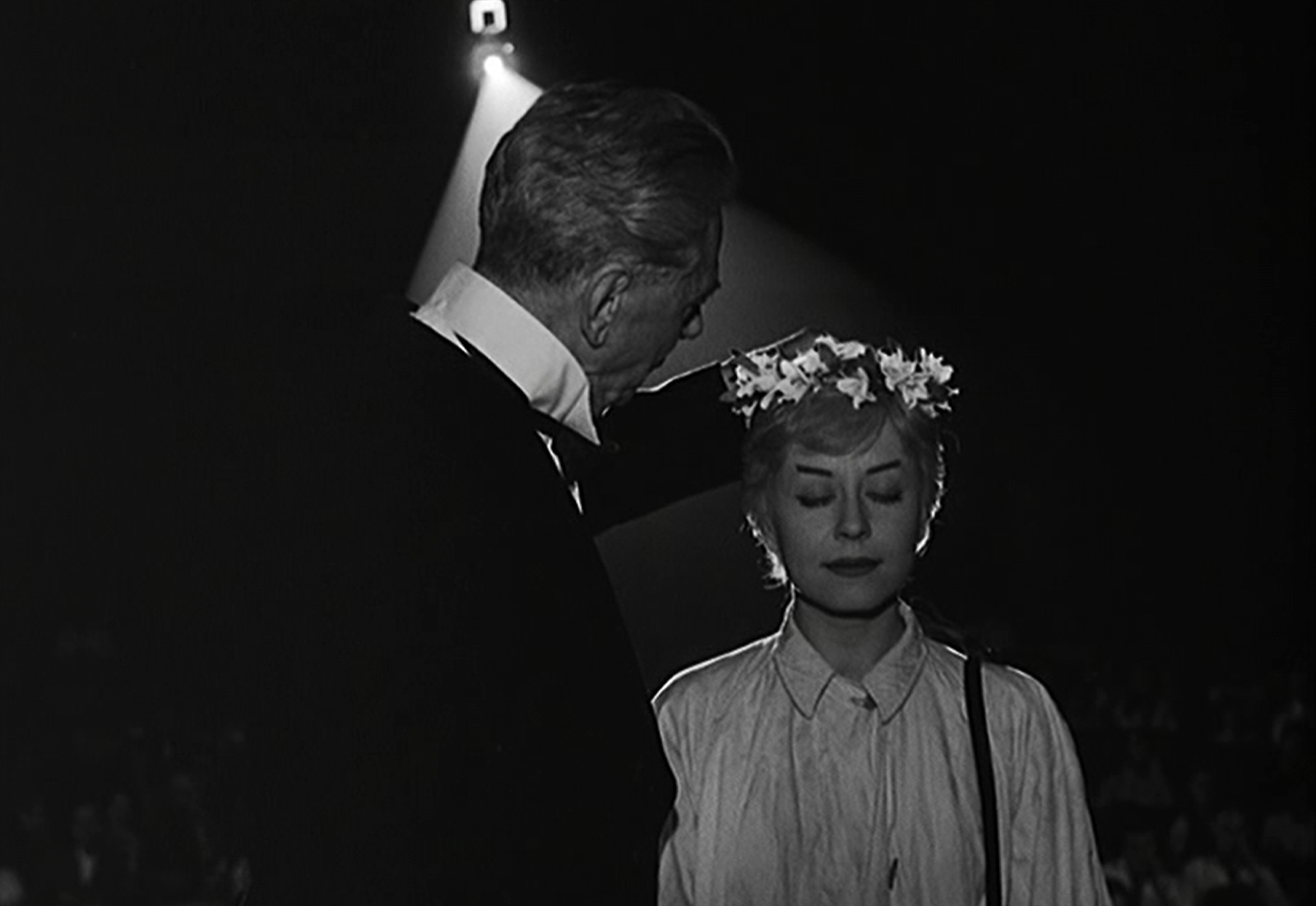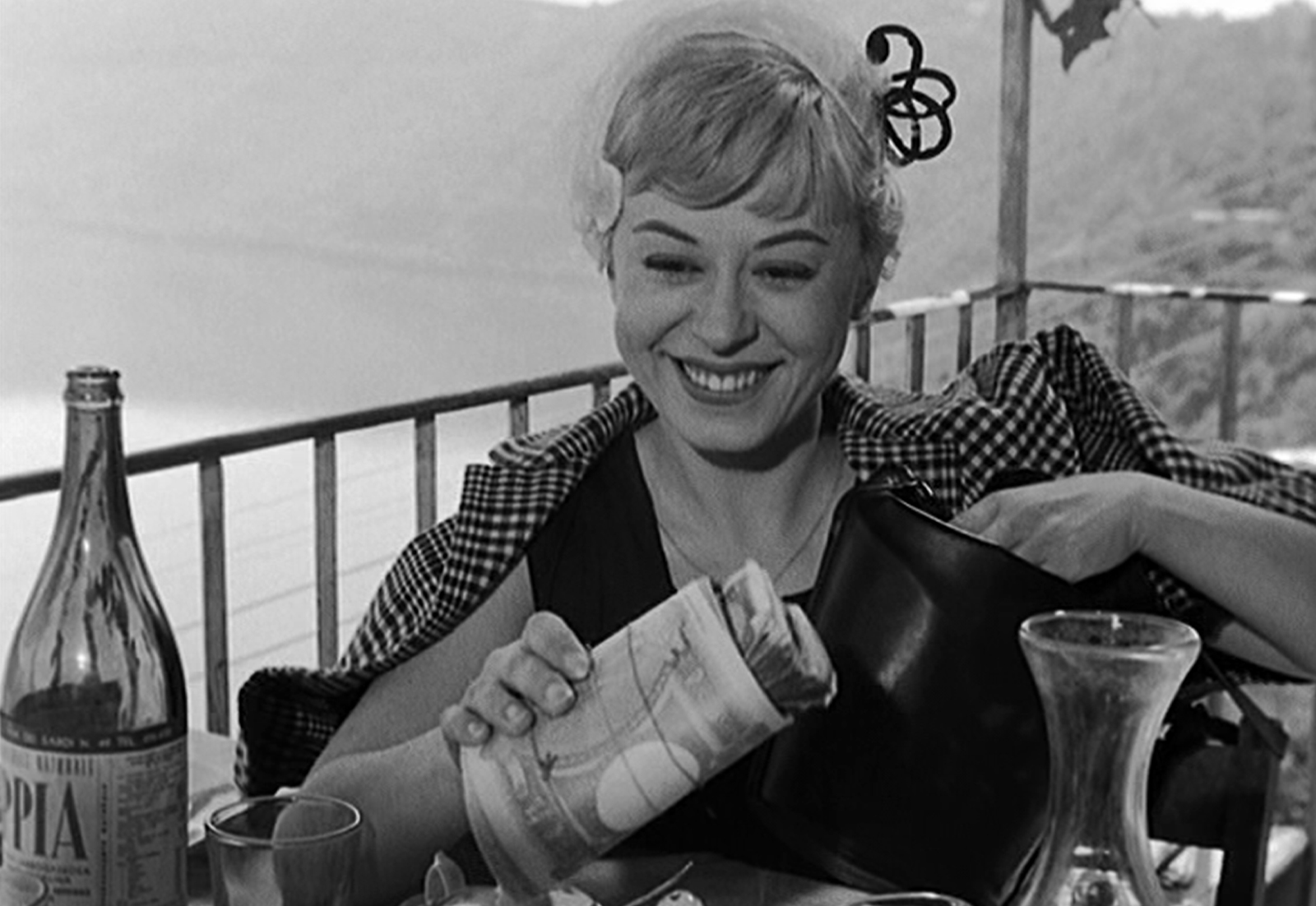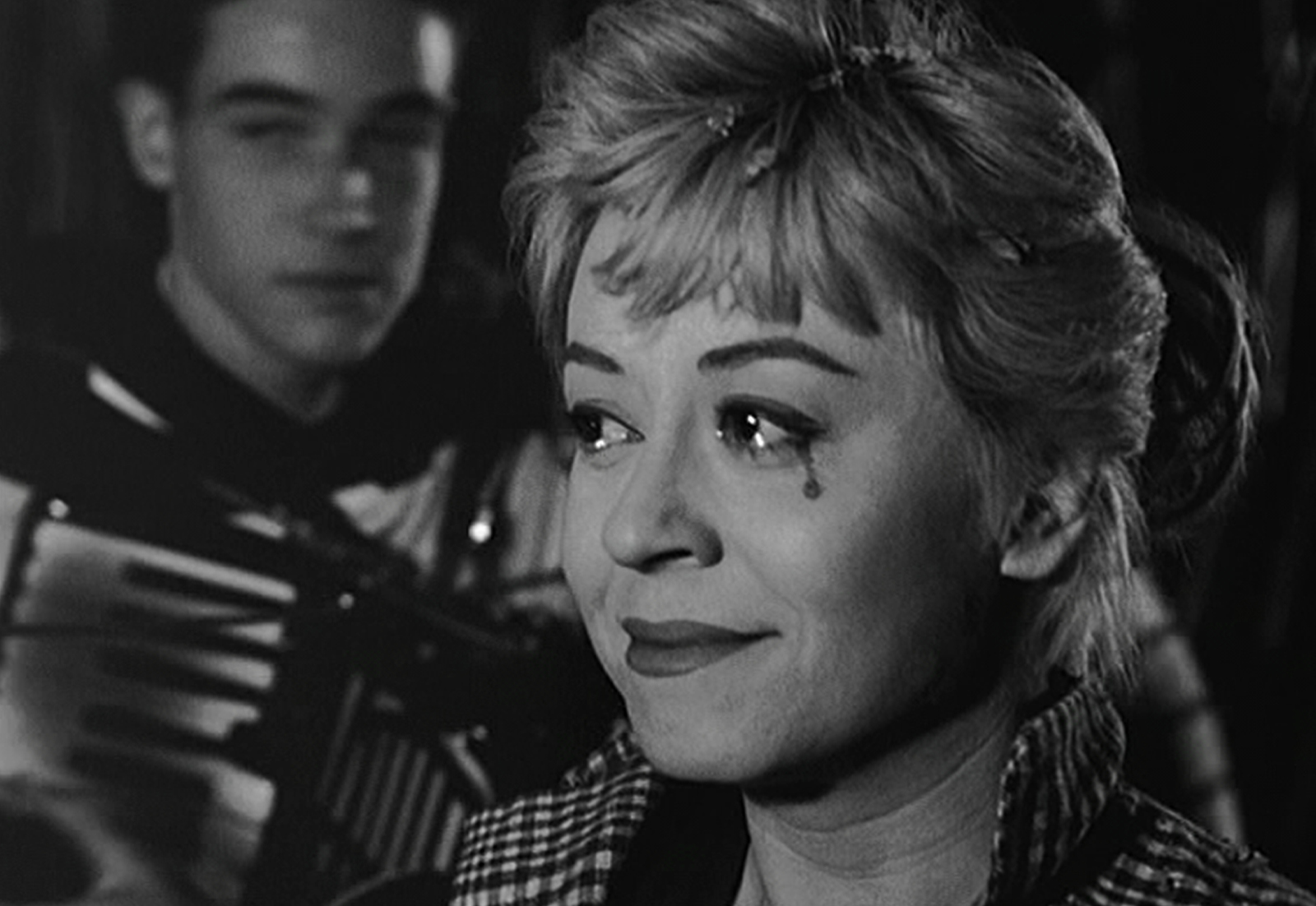NIGHTS OF CABIRIA (LE NOTTI DI CABIRIA)




2:15PM, Saturday May 2
Randwick Ritz
Director: Federico Fellini
Country: Italy/France
Year: 1957
Runtime: 117 minutes
Rating: M
Single tickets on sale soon. Get a subscription to the full program now ⟶
“There is more grace
and courage in the famous image of Giulietta Masina smiling through her tears
in Federico Fellini's 1957 Nights of
Cabiria, the restored treasure of the summer movie season, than there is in
all the fire-breathing blockbusters Hollywood has to offer ... a cinematic
masterpiece.”
— Janet Maslin, The New York Times
Fellini won a Foreign-language Oscar for La Strada in 1956, a success the director repeated in 1957 with his next film, Nights of Cabiria.The film again starred Fellini’s wife, the scintillating Giulietta Masina, who won best Actress at Cannes for her performance as the much put-upon but always resilient Cabiria, the streetwalker with a heart of gold. The latest digital restoration of the film commissioned by StudioCanal has been timed to celebrate the director’s 100th anniversary.
Nights of Cabiria screens as part of Celebrating Federico Fellini, a series which also includes Fellini vs Visconti: Italian Standoff.
Cinema Reborn is grateful for the support of the Instituto Italiano Di Cultura in the presentation of our Tribute to Federico Fellini.

Notes by John Baxter:
Federico Fellini and Nights of Cabiria
The relationship between Federico Fellini and his wife and star Giulietta Masina was as competitive as it was affectionate. Recognizing that the success of La Strada was due largely to her performance as the victimised but ever-hopeful Gelsomina, he did his best to make his next project one in which she didn’t feature, and which, moreover, didn’t involve producer Dino de Laurentiis, forever pressuring Fellini to be more commercial. He considered a film about a saintly nun, another set in a mental hospital, even a Hollywood western, but each failure led back to Dino and Giulietta.
Resignedly, he resuscitated the Roman prostitute encountered by Leopoldo Trieste in The White Sheik. Chronically unlucky, Maria Cecciara is nicknamed ‘Cabiria’ by her friends after the hapless Sicilian maiden of Pastrone’s 1913 drama, harried from the eruption of Etna to Carthaginian slavery, only to end up in the arena before being rescued by her patrician lover Fulvio. In an ironic nod to this genealogy, the modern Cabiria works among the ruins of ancient Rome, on its Passeggiata Archeologica, the Archaeological Walk near the Baths of Caracalla. That Maria accepts this nickname says a lot about Fellini’s conception of her character. Driven by the belief that somewhere a Fulvio awaits her, she prides herself most on her ability to survive. “She resembles me very much,” Masina said. “Naïve, aggressive and finally very strong.”
Fellini’s notebooks, the source of almost all his ideas, provived plenty of incidents for the film he called Nights of Cabiria. While filming Il bidone, the crew encountered a prostitute named Wanda who protested at camera tracks blocking her door. Fellini won her with one of the box lunches provided for the crew. Through her, he came to know something of a prostitute’s life.
Meanwhile, screenwriter Tullio Pinelli read a newspaper story about the discovery of a woman’s head in Lake Albano. “We imagined the story of a prostitute full of human warmth who had a need for love,” Pinelli says, “but who always fell in love with pimps who try to kill her. The film starts with an individual who throws her in the Tiber and ends with a type who wants to throw her in the lake at Castel Gandolfo.” Ennio Flaiano was brought in, and the three went off for a two-week stay in a hotel. Remembering an idea rejected by Anna Magnani for Amore, of a star who takes home a street hooker, only to abandon her when his girlfriend returns, Pinelli suggested they insert it. Fellini also threw “a wine and pasta dinner” for “former owners of brothels”, who told “tragic tales of prostitutes.” (“Many wept like babies,” he recalled, presumably tongue in cheek.)
Visually, Cabiria was the joint creation of Fellini and a new collaborator, Piero Gherardi, who had an encyclopedic knowledge of Rome. They were improbable colleagues. Gherardi, elegant and vague, belonged to the Florentine aristocracy and was, properly, a count. His squirearchical roots were never far from the surface. In London in 1969 to design The White Devil for the National Theatre, he startled a critic by suggesting they hire horses and go riding in Regent’s Park.
In character, however, Fellini and Gherardi were well matched. Both enjoyed late-night walks around Rome. They researched Cabiria on a series of such strolls, Gherardi leading Fellini to exactly the building or background he wanted. “Even before a film has taken complete form in my head,” Fellini said, “he has understood what it’s about, the atmosphere, and comes up with ideas and sketches which clarify things for me.”
Between them they built a ‘look’ for Cabiria, a queasy combination of the coquettish and practical that reflected her character and improved on that created for The White Sheik. To a ratty fur jacket and a collapsible umbrella from which she’s inseparable, they added a black skirt and striped T-shirt, bobby-socks and a plastic rain hat. For the rest of the prostitutes, Gherardi simply borrowed clothes from the whores who acted as ‘technical advisers’.
For the character of Oscar, the lover who so cruelly betrays her, Fellini wanted Leopoldo Trieste, but the French company on which Dino had laid off part of his investment demanded someone French. François Périer, whose career included Cocteau’s Orphée, was not everyone’s idea of a Roman con man. Since the actor didn’t project ingratiating menace, Fellini had to impose it. He had him wait for his first date with Cabiria while chewing a toothpick, and instructed him during their last meal to put on a pair of dark glasses. As these are associated in all Fellini’s films with unreliability, the sense of betrayal is instant and pointed.
Once La Strada was nominated for the Oscar it later won, de Laurentiis delayed releasing Cabiria until after May 1957, by which time it had also been screened at Cannes. François Truffaut, then a critic, called it “the most eagerly awaited film of the festival” and “the only one to arouse much comment at the exits.” Until three in the morning, he said, Giulietta’s role was “the subject of violent argument.” She duly won the Palme d’Or for best actress, for the second time.
Many at Cannes thought the film too long. It would be cut soon after, but not for reasons of length. Its general release required an Italian censorship certificate. That this was not immediately forthcoming was no surprise. Before filming was finished, the authorities had voiced doubts. Ostensibly the problem was the theme of prostitution. Fellini argued, rightly, that, except for a few references to ‘customers’ by the girls and one shot where a truck driver picks up Cabiria, their job is never mentioned, nor is there either sex or nudity in the film.
When the cloud remained, it became clear the real problem was the Church. Cabiria shows priests as either greedy, like the merchandisers of spurious cures at the shrine, or holy fools, like Brother Giovanni, a beaming simpleton who meets Cabiria in the wasteland near her home, dispenses homilies about the holiness of matrimony, then wanders away. True charity is represented by a character called simply The Man With the Sack, who moves anonymously among the poor, dispensing food and clothing without reference to any creed.
The film was saved with the help of the Jesuit Angelo Arpa, who arranged a screening for Giuseppe Siri, the Church’s youngest cardinal. Anxious to create the right impression, Fellini scoured antique shops for a chair appropriate for a prince of the Church, and found a sort of throne, with gold piping and a large red cushion. Siri and Arpa arrived in a chauffeured Mercedes after midnight, entered the cinema and closed the door. Fellini remained outside. When they emerged, the cardinal said simply ‘Poor Cabiria, we ought to do something for her.’ A phone call was made and all objections, secular and religious, evaporated; all, that is, save one. Fellini was asked to drop The Man with the Sack. Charity in Italy is traditionally the Church’s prerogative and he assumed a Vatican bureaucrat was galled to see a layman doing its job. Some, however, suspected the whole story to be an invention by the Machiavellian de Laurentiis, who shortened the film for purely commercial reasons. For a film suffused with deviousness and duplicity, it would have been an entirely appropriate conclusion.
Resignedly, he resuscitated the Roman prostitute encountered by Leopoldo Trieste in The White Sheik. Chronically unlucky, Maria Cecciara is nicknamed ‘Cabiria’ by her friends after the hapless Sicilian maiden of Pastrone’s 1913 drama, harried from the eruption of Etna to Carthaginian slavery, only to end up in the arena before being rescued by her patrician lover Fulvio. In an ironic nod to this genealogy, the modern Cabiria works among the ruins of ancient Rome, on its Passeggiata Archeologica, the Archaeological Walk near the Baths of Caracalla. That Maria accepts this nickname says a lot about Fellini’s conception of her character. Driven by the belief that somewhere a Fulvio awaits her, she prides herself most on her ability to survive. “She resembles me very much,” Masina said. “Naïve, aggressive and finally very strong.”
Fellini’s notebooks, the source of almost all his ideas, provived plenty of incidents for the film he called Nights of Cabiria. While filming Il bidone, the crew encountered a prostitute named Wanda who protested at camera tracks blocking her door. Fellini won her with one of the box lunches provided for the crew. Through her, he came to know something of a prostitute’s life.
Meanwhile, screenwriter Tullio Pinelli read a newspaper story about the discovery of a woman’s head in Lake Albano. “We imagined the story of a prostitute full of human warmth who had a need for love,” Pinelli says, “but who always fell in love with pimps who try to kill her. The film starts with an individual who throws her in the Tiber and ends with a type who wants to throw her in the lake at Castel Gandolfo.” Ennio Flaiano was brought in, and the three went off for a two-week stay in a hotel. Remembering an idea rejected by Anna Magnani for Amore, of a star who takes home a street hooker, only to abandon her when his girlfriend returns, Pinelli suggested they insert it. Fellini also threw “a wine and pasta dinner” for “former owners of brothels”, who told “tragic tales of prostitutes.” (“Many wept like babies,” he recalled, presumably tongue in cheek.)
Visually, Cabiria was the joint creation of Fellini and a new collaborator, Piero Gherardi, who had an encyclopedic knowledge of Rome. They were improbable colleagues. Gherardi, elegant and vague, belonged to the Florentine aristocracy and was, properly, a count. His squirearchical roots were never far from the surface. In London in 1969 to design The White Devil for the National Theatre, he startled a critic by suggesting they hire horses and go riding in Regent’s Park.
In character, however, Fellini and Gherardi were well matched. Both enjoyed late-night walks around Rome. They researched Cabiria on a series of such strolls, Gherardi leading Fellini to exactly the building or background he wanted. “Even before a film has taken complete form in my head,” Fellini said, “he has understood what it’s about, the atmosphere, and comes up with ideas and sketches which clarify things for me.”
Between them they built a ‘look’ for Cabiria, a queasy combination of the coquettish and practical that reflected her character and improved on that created for The White Sheik. To a ratty fur jacket and a collapsible umbrella from which she’s inseparable, they added a black skirt and striped T-shirt, bobby-socks and a plastic rain hat. For the rest of the prostitutes, Gherardi simply borrowed clothes from the whores who acted as ‘technical advisers’.
For the character of Oscar, the lover who so cruelly betrays her, Fellini wanted Leopoldo Trieste, but the French company on which Dino had laid off part of his investment demanded someone French. François Périer, whose career included Cocteau’s Orphée, was not everyone’s idea of a Roman con man. Since the actor didn’t project ingratiating menace, Fellini had to impose it. He had him wait for his first date with Cabiria while chewing a toothpick, and instructed him during their last meal to put on a pair of dark glasses. As these are associated in all Fellini’s films with unreliability, the sense of betrayal is instant and pointed.
Once La Strada was nominated for the Oscar it later won, de Laurentiis delayed releasing Cabiria until after May 1957, by which time it had also been screened at Cannes. François Truffaut, then a critic, called it “the most eagerly awaited film of the festival” and “the only one to arouse much comment at the exits.” Until three in the morning, he said, Giulietta’s role was “the subject of violent argument.” She duly won the Palme d’Or for best actress, for the second time.
Many at Cannes thought the film too long. It would be cut soon after, but not for reasons of length. Its general release required an Italian censorship certificate. That this was not immediately forthcoming was no surprise. Before filming was finished, the authorities had voiced doubts. Ostensibly the problem was the theme of prostitution. Fellini argued, rightly, that, except for a few references to ‘customers’ by the girls and one shot where a truck driver picks up Cabiria, their job is never mentioned, nor is there either sex or nudity in the film.
When the cloud remained, it became clear the real problem was the Church. Cabiria shows priests as either greedy, like the merchandisers of spurious cures at the shrine, or holy fools, like Brother Giovanni, a beaming simpleton who meets Cabiria in the wasteland near her home, dispenses homilies about the holiness of matrimony, then wanders away. True charity is represented by a character called simply The Man With the Sack, who moves anonymously among the poor, dispensing food and clothing without reference to any creed.
The film was saved with the help of the Jesuit Angelo Arpa, who arranged a screening for Giuseppe Siri, the Church’s youngest cardinal. Anxious to create the right impression, Fellini scoured antique shops for a chair appropriate for a prince of the Church, and found a sort of throne, with gold piping and a large red cushion. Siri and Arpa arrived in a chauffeured Mercedes after midnight, entered the cinema and closed the door. Fellini remained outside. When they emerged, the cardinal said simply ‘Poor Cabiria, we ought to do something for her.’ A phone call was made and all objections, secular and religious, evaporated; all, that is, save one. Fellini was asked to drop The Man with the Sack. Charity in Italy is traditionally the Church’s prerogative and he assumed a Vatican bureaucrat was galled to see a layman doing its job. Some, however, suspected the whole story to be an invention by the Machiavellian de Laurentiis, who shortened the film for purely commercial reasons. For a film suffused with deviousness and duplicity, it would have been an entirely appropriate conclusion.
